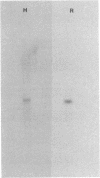Abstract
Present understanding of gene expression in erythropoietic tissues is derived solely from studies of the globin genes. Of the three distinct carbonic anhydrase (carbonate dehydratase; carbonate hydro-lyase, EC 4.2.1.1) isozymes, carbonic anhydrase I is erythrocyte-specific and, in humans, is under developmental control. The appearance of carbonic anhydrase I in the erythrocyte late in fetal life follows closely the gamma- to beta-globin switch. In order to study the expression of this erythrocyte-specific nonglobin protein, we set out to isolate a cloned carbonic anhydrase I cDNA. A mixture of 17-base-long synthetic oligonucleotides was used as an in situ hybridization probe to screen a rabbit reticulocyte cDNA library. Two clones were isolated, and the complete nucleotide sequence of the clone with the largest insert was determined and shown to code for carbonic anhydrase I. This clone, designated pRCAI, is near full length and has provided the 40% of the amino acid sequence of rabbit carbonic anhydrase I, which was not known hitherto. The deduced primary structure has revealed potentially significant changes in the vicinity of the active site of the rabbit carbonic anhydrase I when compared with carbonic anhydrase I and II sequences from other species.
Full text
PDF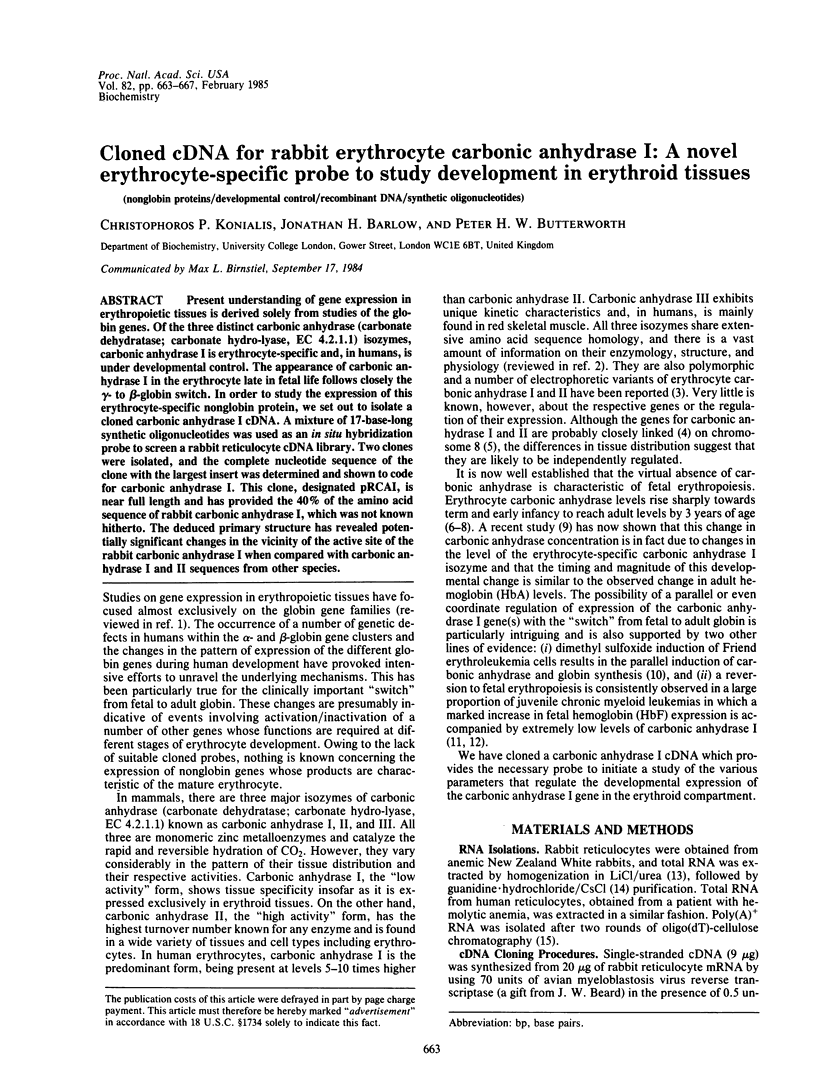
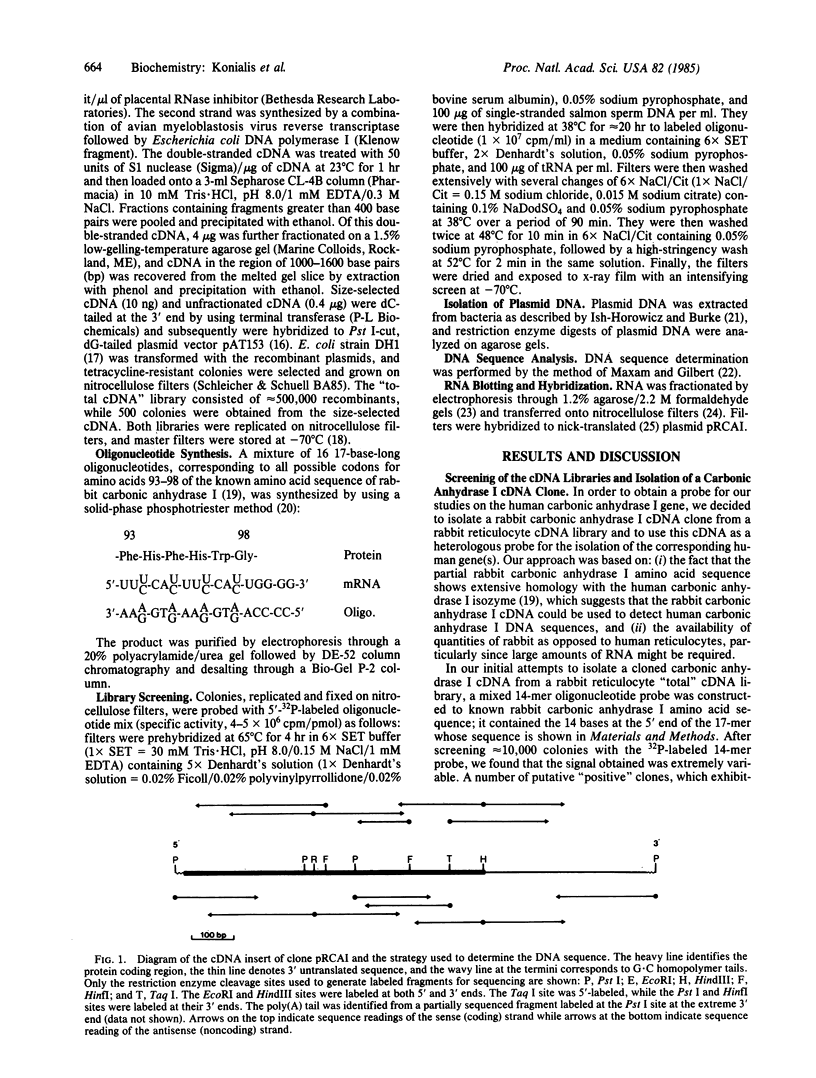
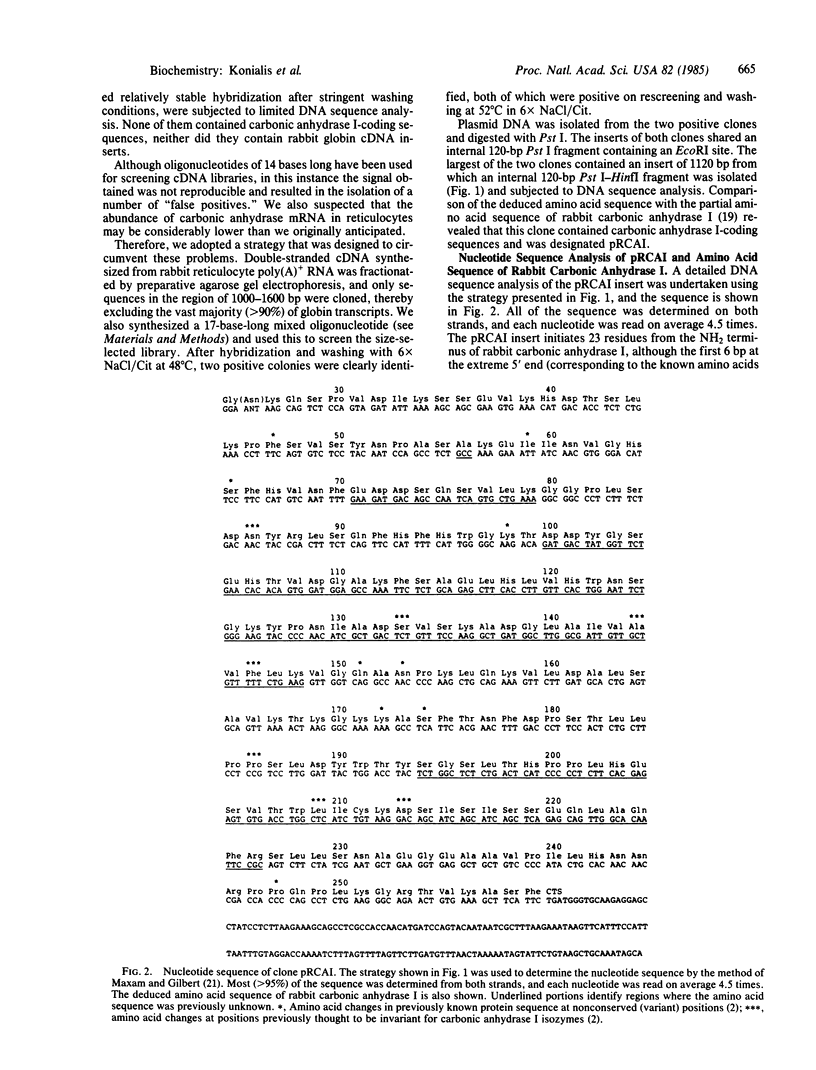
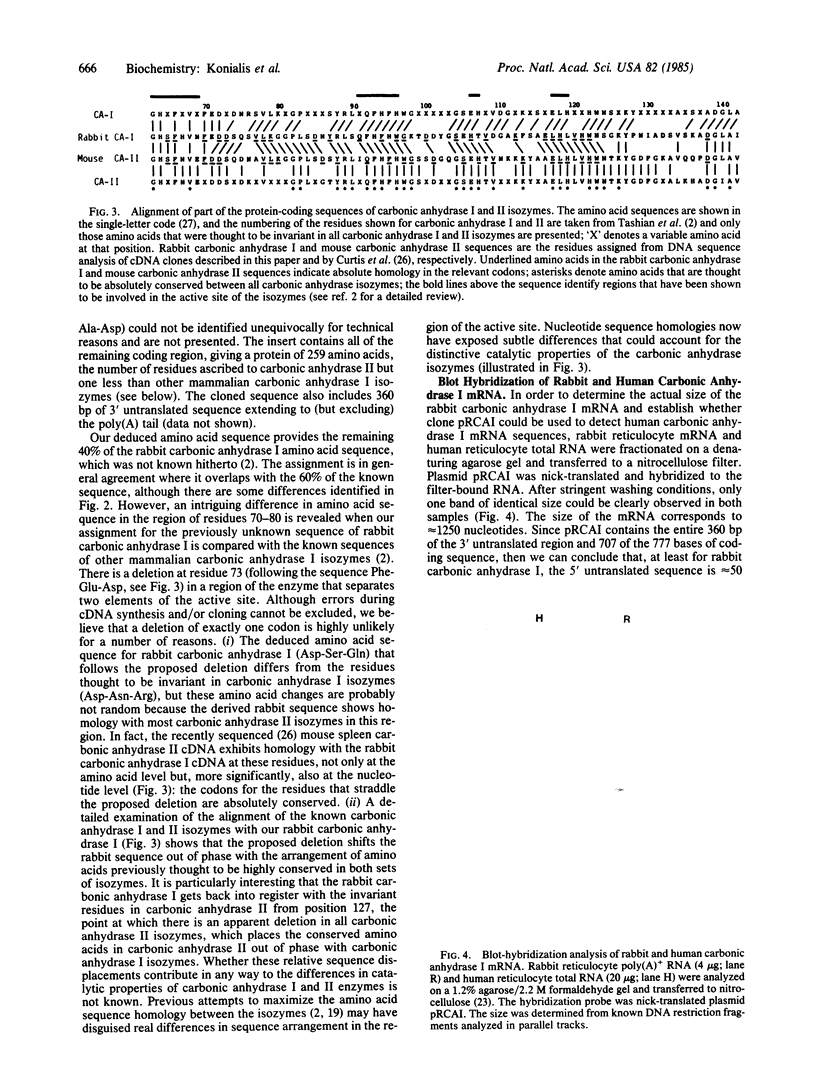
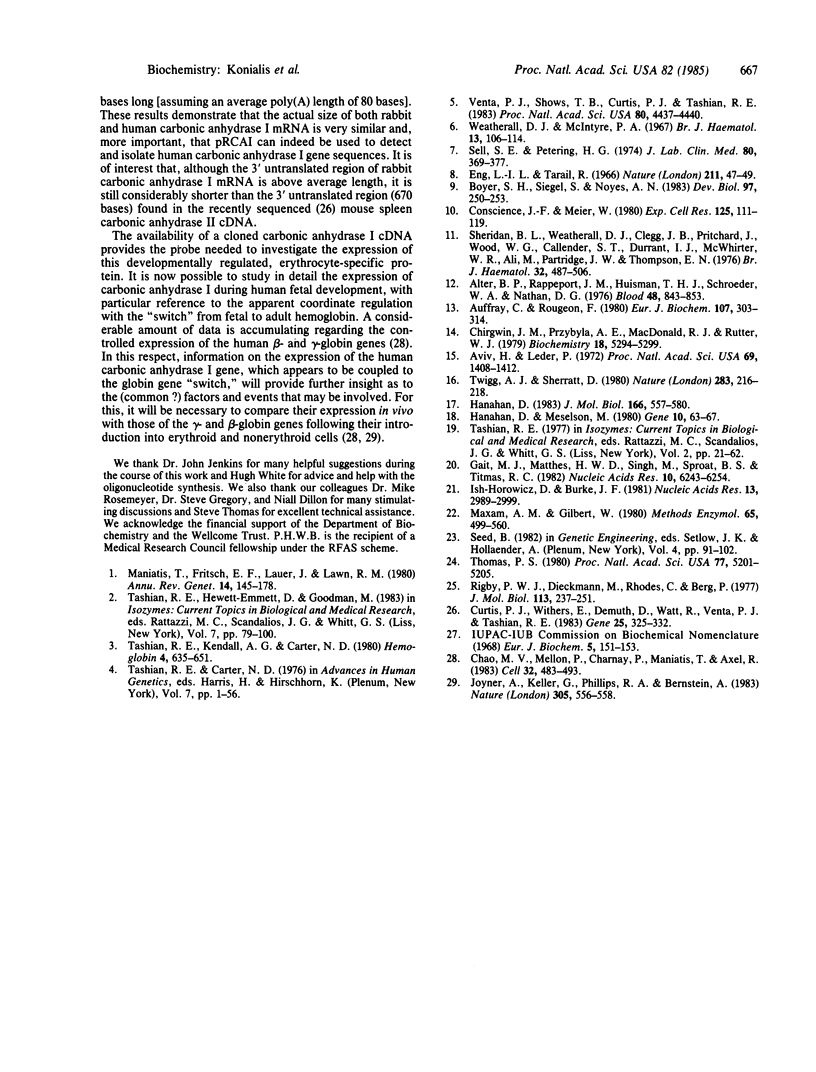
Images in this article
Selected References
These references are in PubMed. This may not be the complete list of references from this article.
- Alter B. P., Rappeport J. M., Huisman T. H., Schroeder W. A., Nathan D. G. Fetal erythropoiesis following bone marrow transplantation. Blood. 1976 Dec;48(6):843–853. [PubMed] [Google Scholar]
- Auffray C., Rougeon F. Purification of mouse immunoglobulin heavy-chain messenger RNAs from total myeloma tumor RNA. Eur J Biochem. 1980 Jun;107(2):303–314. doi: 10.1111/j.1432-1033.1980.tb06030.x. [DOI] [PubMed] [Google Scholar]
- Aviv H., Leder P. Purification of biologically active globin messenger RNA by chromatography on oligothymidylic acid-cellulose. Proc Natl Acad Sci U S A. 1972 Jun;69(6):1408–1412. doi: 10.1073/pnas.69.6.1408. [DOI] [PMC free article] [PubMed] [Google Scholar]
- Boyer S. H., Siegel S., Noyes A. N. Developmental changes in human erythrocyte carbonic anhydrase levels: coordinate expression with adult hemoglobin. Dev Biol. 1983 May;97(1):250–253. doi: 10.1016/0012-1606(83)90083-0. [DOI] [PubMed] [Google Scholar]
- Chao M. V., Mellon P., Charnay P., Maniatis T., Axel R. The regulated expression of beta-globin genes introduced into mouse erythroleukemia cells. Cell. 1983 Feb;32(2):483–493. doi: 10.1016/0092-8674(83)90468-3. [DOI] [PubMed] [Google Scholar]
- Chirgwin J. M., Przybyla A. E., MacDonald R. J., Rutter W. J. Isolation of biologically active ribonucleic acid from sources enriched in ribonuclease. Biochemistry. 1979 Nov 27;18(24):5294–5299. doi: 10.1021/bi00591a005. [DOI] [PubMed] [Google Scholar]
- Conscience J. F., Meier W. Coordinate expression of erythroid marker enzymes during dimethylsulfoxide-induced differentiation of Friend erythroleukemia cells. Exp Cell Res. 1980 Jan;125(1):111–119. doi: 10.1016/0014-4827(80)90195-0. [DOI] [PubMed] [Google Scholar]
- Curtis P. J., Withers E., Demuth D., Watt R., Venta P. J., Tashian R. E. The nucleotide sequence and derived amino acid sequence of cDNA coding for mouse carbonic anhydrase II. Gene. 1983 Nov;25(2-3):325–332. doi: 10.1016/0378-1119(83)90237-8. [DOI] [PubMed] [Google Scholar]
- Gait M. J., Matthes H. W., Singh M., Sproat B. S., Titmas R. C. Rapid synthesis of oligodeoxyribonucleotides. VII. Solid phase synthesis of oligodeoxyribonucleotides by a continuous flow phosphotriester method on a kieselguhr-polyamide support. Nucleic Acids Res. 1982 Oct 25;10(20):6243–6254. doi: 10.1093/nar/10.20.6243. [DOI] [PMC free article] [PubMed] [Google Scholar]
- Hanahan D., Meselson M. Plasmid screening at high colony density. Gene. 1980 Jun;10(1):63–67. doi: 10.1016/0378-1119(80)90144-4. [DOI] [PubMed] [Google Scholar]
- Hanahan D. Studies on transformation of Escherichia coli with plasmids. J Mol Biol. 1983 Jun 5;166(4):557–580. doi: 10.1016/s0022-2836(83)80284-8. [DOI] [PubMed] [Google Scholar]
- Ish-Horowicz D., Burke J. F. Rapid and efficient cosmid cloning. Nucleic Acids Res. 1981 Jul 10;9(13):2989–2998. doi: 10.1093/nar/9.13.2989. [DOI] [PMC free article] [PubMed] [Google Scholar]
- Joyner A., Keller G., Phillips R. A., Bernstein A. Retrovirus transfer of a bacterial gene into mouse haematopoietic progenitor cells. Nature. 1983 Oct 6;305(5934):556–558. doi: 10.1038/305556a0. [DOI] [PubMed] [Google Scholar]
- Luan ENG L. I., Tarail R. Carbonic anhydrase deficiency with persistence of foetal haemoglobin: a new syndrome. Nature. 1966 Jul 2;211(5044):47–49. doi: 10.1038/211047a0. [DOI] [PubMed] [Google Scholar]
- Maniatis T., Fritsch E. F., Lauer J., Lawn R. M. The molecular genetics of human hemoglobins. Annu Rev Genet. 1980;14:145–178. doi: 10.1146/annurev.ge.14.120180.001045. [DOI] [PubMed] [Google Scholar]
- Maxam A. M., Gilbert W. Sequencing end-labeled DNA with base-specific chemical cleavages. Methods Enzymol. 1980;65(1):499–560. doi: 10.1016/s0076-6879(80)65059-9. [DOI] [PubMed] [Google Scholar]
- Rigby P. W., Dieckmann M., Rhodes C., Berg P. Labeling deoxyribonucleic acid to high specific activity in vitro by nick translation with DNA polymerase I. J Mol Biol. 1977 Jun 15;113(1):237–251. doi: 10.1016/0022-2836(77)90052-3. [DOI] [PubMed] [Google Scholar]
- Sell J. E., Petering H. G. Carbonic anhydrases from human neonatal erythrocytes. J Lab Clin Med. 1974 Sep;84(3):369–377. [PubMed] [Google Scholar]
- Sheridan B. L., Weatherall D. J., Clegg J. B., Pritchard J., Wood W. G., Callender S. T., Durrant I. J., McWhirter W. R., Ali M., Partridge J. W. The patterns of fetal haemoglobin production in leukaemia. Br J Haematol. 1976 Apr;32(4):487–506. doi: 10.1111/j.1365-2141.1976.tb00952.x. [DOI] [PubMed] [Google Scholar]
- Tashian R. E., Kendall A. G., Carter N. D. Inherited variants of human red cell carbonic anhydrases. Hemoglobin. 1980;4(5-6):635–651. doi: 10.3109/03630268008997733. [DOI] [PubMed] [Google Scholar]
- Thomas P. S. Hybridization of denatured RNA and small DNA fragments transferred to nitrocellulose. Proc Natl Acad Sci U S A. 1980 Sep;77(9):5201–5205. doi: 10.1073/pnas.77.9.5201. [DOI] [PMC free article] [PubMed] [Google Scholar]
- Twigg A. J., Sherratt D. Trans-complementable copy-number mutants of plasmid ColE1. Nature. 1980 Jan 10;283(5743):216–218. doi: 10.1038/283216a0. [DOI] [PubMed] [Google Scholar]
- Venta P. J., Shows T. B., Curtis P. J., Tashian R. E. Polymorphic gene for human carbonic anhydrase II: a molecular disease marker located on chromosome 8. Proc Natl Acad Sci U S A. 1983 Jul;80(14):4437–4440. doi: 10.1073/pnas.80.14.4437. [DOI] [PMC free article] [PubMed] [Google Scholar]
- Weatherall D. J., McIntyre P. A. Developmental and acquired variations in erythrocyte carbonic anhydrase isozymes. Br J Haematol. 1967 Jan;13(1):106–114. doi: 10.1111/j.1365-2141.1967.tb08699.x. [DOI] [PubMed] [Google Scholar]



